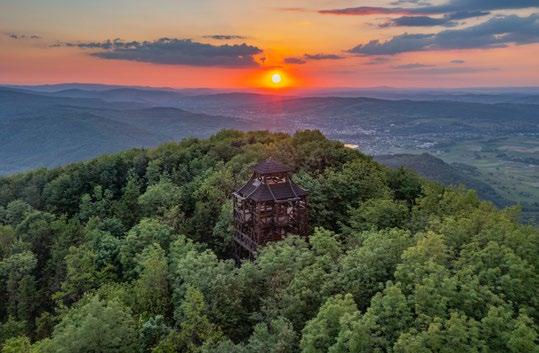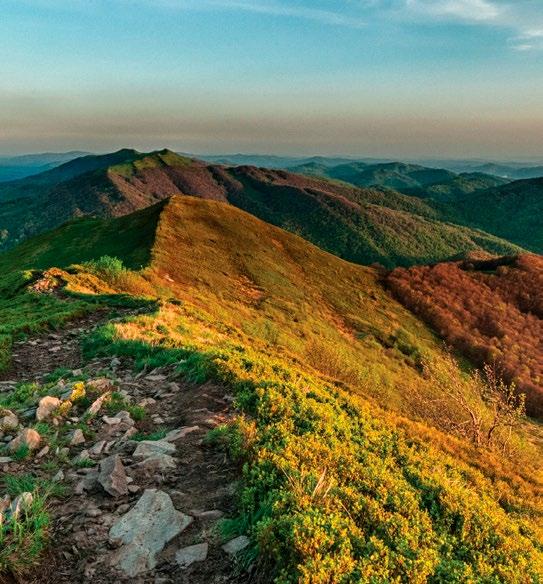
13 minute read
Carpathia Carpathia
A mystical land in the heart of Europe. A mysterious mountain massif, hiding natural wonders and the rich diversity of nature. A place where, among peaceful valleys and shady forests, the East meets the West. Multiculturalism, authenticity, reverence towards nature, and a sense of grandeur these are the pillars of CARPATHIA, the flagship project of Euroregion Karpacki (Carpathian Euroregion - the oldest and largest cross-border structure in the Carpathian Mountains). An innovative initiative to better integrate and enhance the tourist economies of this unique international region, CARPATHIA is home to territorial and thematic sub-brands, including UNESCO, CITIES, ACTIVE and CULTURE, that invite engagement from people across the globe. The mission of CARPATHIA is universal, but also intensely personal. The slogan, ‘Listen to yourself,’ proposes the opportunity for a spiritual transformation through contact with Carpathian spaces. The Low Beskids, Bardejov, Bukovina and Saris are just some of the key places where the CARPATHIA project interacts with the strong authenticity, richness and vibrancy of its inhabitants and landscapes. Together with the Carpathian Convention and partners from the Carpathian countries, we are creating a destination of global relevance. CARPATHIA - the international mark of Carpathian quality - calls explorers, tourists and investors to discover this inspiring region. See you here soon…
The CARPATHIA Team
Advertisement
Association of the Carpathian Euroregion 2 Kilińskiego Sq, 35-005 Rzeszów www.karpacki.pl
Funded by the National Freedom Institute – Centre for Civil Society Development within Civil Society Organisations Development Programme 2018–2030
Introducing Podkarpackie
Active Tourism
Nestled in the southeast corner of Poland, Podkarpackie is an active traveller’s dream destination. From hiking in the untamed wilderness of the Bieszczady Mountains, to kayaking or cycling along the serpentine San River, to sailing on serene Lake Solina, Podkarpackie caters to outdoor enthusiasts of all skill levels and interests. It’s not only trees, streams and stones, however. Throughout the bucolic landscapes are plenty of charming villages, cultural attractions and historical sites to uncover. Urban explorers will be drawn to the massive fortifications ringing Przemyśl, the Palace in Krasiczyn will lure architecture fans and fairy tale fabulists, while rail buffs will want to trace ‘Poland’s most beautiful train line.’ More than that even, the region also possesses a rustic, romantic mystique that will inspire artistic souls. It’s this combination of peaceful landscapes, cultural richness and nostalgic awe that truly makes the region unique. As the local slogan ‘Rzuć wszystko jedź...' goes, drop everything and go to Podkarpackie!
For more travel info on the region visit iyp.me/podkarpackie Happy trails!
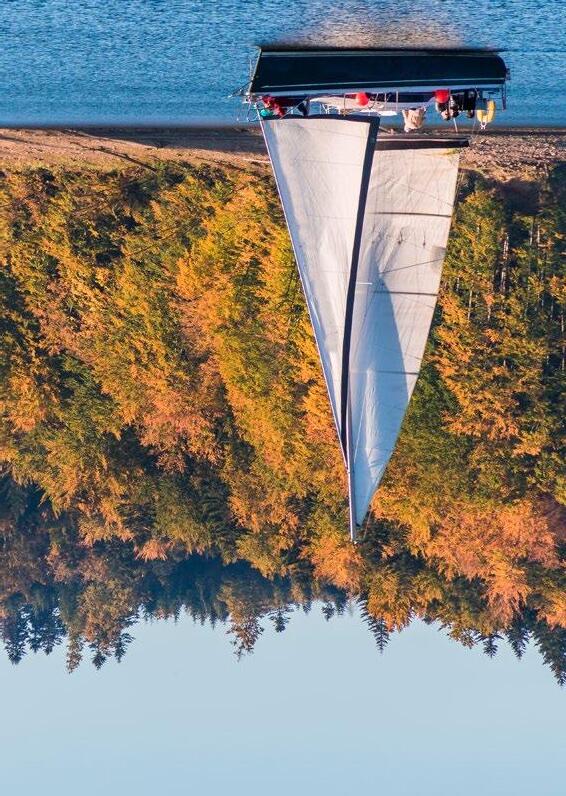

Publisher: IYP City Guides Sp. z o.o. Sp.k., ul. Karmelicka 46/51, 31-128 Kraków iyp.com.pl
Make a Splash at Lake Solina
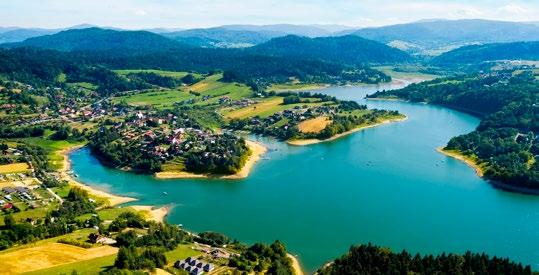
This lovely lake in the heart of Bieszczady is just as popular as the mountains that surround it - even more so with holidaymakers simply looking for rest and relaxation. Created in 1968 by damming the San River, this is Poland’s largest artificial lake at 22km2, and offers an array of water sports, wild beaches, vacation vibes and gorgeous scenery.
Sites
While the shores around the waterside villages of Solina Myczków and the mini-health resort of Polańczyk are quite developed, other parts of Lake Solina are completely untouched. Family attractions (rope parks, water parks, etc.) are plentiful, as are restaurants serving freshly caught fish. The dam in Solina is quite an engineering marvel and worth a visit; the largest dam in PL, you can walk across it or take the 1.5km cableway over it for amazing views. The observation tower on Jawor also offers great views, and you can learn about the history and customs of Carpathian highlanders at the Museum of Boyko Culture in Myczków.
Activities
Pretty much any water sport you can dream up is available here, with most activities based out of Solina and Polańczyk. In addition to kayaks, canoes, stand-up paddle boards (SUP), pedal boats and sailboards, you can also rent sailboats and even 12-person yachts. If you don’t have a sailing licence, scenic lake cruises are also offered.
Kayaking on the San River
Start your kayaking adventures with a relaxing downriver paddle on the gorgeous San River. Undemanding and very scenic, avid wildlife spotters and bird enthusiasts will especially be in for a treat. The length of the route can be adjusted to your liking, and features extensive infrastructure for larger groups and overnight campers.
Route
Along this calm 59km section of the San between Dynów and Krasiczyn you’ll float through farming lands, forests, and past several villages. There are plenty of places along the route to stop and get off the water for a bit, including some well-organised picnic areas with covered tables and trash bins. The villages of Słonne and Chyrzyna have campgrounds, while Słonne and Krasice have glamping/camping resorts with small wooden cabins located right on the forested shores of the river. The perfect opportunity to try an overnight kayaking trip, go the full distance to Krasiczyn and your reward is a visit to the stunning Renaissance Palace once your get your legs under you again.
Sites
There isn’t much between Dynów and Krasiczyn, but this adventure is about relaxing in nature, right? That said, anyone interested in the region’s Jewish community/heritage should visit the Centre for the History of Polish Jews in Dynów (ul. Łazienna 70). A real rarity in PL today, the centre includes a synagogue, mikveh, kosher kitchen and guestrooms, and is just metres from the riverside.

Just before Chyrzyna you can also put in at the ferry port in Babice where you’ll discover an old overgrown cemetery and an abandoned wooden Greek Catholic church right near the river’s edge. There’s also an old manor house and park hidden in the woods 650m from the river. This is an urbex-style adventure, without the urban aspect.
Lastly, the magnificent Renaissance Palace awaits anyone who makes the trip all the way to Krasiczyn Dating from the turn of the 16th/17th centuries, the castle features many outstanding architectural details and some simply incredible sgraffito on the exterior walls. Surrounded by a lovely park, the palace also hosts a restaurant, wine cellar and hotel, so you might even consider spending the night!
Przemyśl Fortress Cycling Routes
If you happen to be near Przemyśl and fancy a day in the saddle, the city’s Fortress Cycling Routes are a great way to get some exercise and see some history. Flanking Przemyśl to the north and south, these routes combine adrenaline and adventure, offering an opportunity to explore some of the city’s least visited but most intriguing sites.
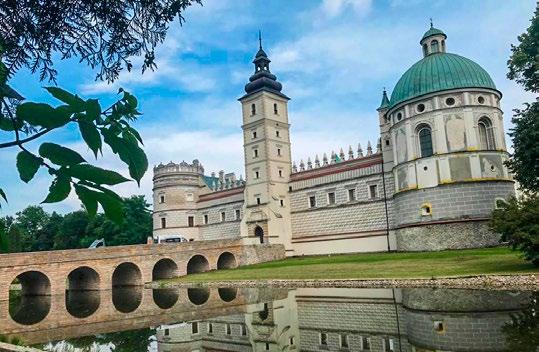
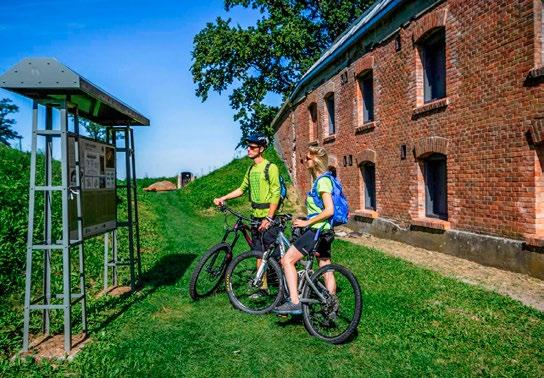
History
One of Europe’s largest fortresses at the start of the 20th century, the Ring Fortress of Przemyśl is a fine example of Austro-Hungarian defensive architecture. Comprised of dozens of individual forts forming a circle around Przemyśl, these sites can still be found atop the surrounding hills and forests. The majority of the forts were deliberately destroyed before being surrendered to the Russians after the Siege of Przemyśl - one of the longest and most brutal battles of WWI in which 100,000 men perished. As such, most lie overgrown and in ruin today, making a visit all the more intimate and intriguing, and two wheels provide the perfect opportunity to explore multiple sites.
Route
If you’re only able to do one of the routes, we recommend the northern route, detailed below. Before heading out, you can pick up a free map of the route in English from the Tourist Info Office on the market square (ul. Grodzka 1), and you might also consider a trip to the Przemyśl Fortress Museum nearby (ul. Katedralna 6). You will need about 6hrs to complete the 33.7km northern route and comfortably see all the sites along the way. A moderate level of fitness is required as there are some ascents, and some sections are in poorer condition than others.
Sites
Entrance to each fort is free and some of the more noteworthy sites in slightly better condition include Fort VIII 'Łętownia,' Fort XI 'Duńkowiczki' and Fort XV 'Borek.' One of the route’s final stops is the excellent Arboretum in Bolestraszyce. With a total of 308 hectares, this gorgeous historical complex includes a fort (naturally), botanical gardens, park, museum and a manor house where the painter Piotr Michałowski lived and worked in the mid-19th century. It’s the ancient trees that are the real standout, however, making it one of our favourite places in the area.
Bieszczady Railway Bikes

Here's one we bet you haven't tried before. In the mountain towns of Bieszczady, the old railway network has been partially repurposed for recreation, and specially-designed pedal cars go trundling along the tracks! A variation on the handcars of old, these carts are passengerpowered 'rail bikes' make for a safe and memorable way to see some beautiful countryside while getting some exercise.
Route
This particular railway line has been called the most beautiful in Poland, and it's hard to argue with that, given the scenery. Known as 'Line 108' it was built in 1872 and connects Zagórz to Krościenko along 47km. Closed only recently, today bike trolleys depart from the station in Uherce Mineralne, and riders can choose the direction they want to go based on the day's fixed schedule. Along the way you'll pass through tunnels, over and under bridges and take in the gorgeous mountain scenery. When it's time to turn back, the accompanying guides physically lift the heavy trolleys off the track and turn them around quite a sight!
Sites
While the pedal trip itself doesn't exactly afford opportunities to turn off for railside attractions, there are a couple of places in Uherce Mineralne that are worth checking out before or after a ride on the rails. The first is the Bieszczady School of Crafts (Uherce Mineralne 137, www. ginacezawody.pl) - an interactive, hands-on museum and cultural centre where you can learn about the old trades of the region, and then try your own skills at some of these disappearing crafts, including calligraphy, pottery and baking sodabread a regional speciality - from scratch. Even if you aren’t up for a workshop, it’s worth checking out their gift shop selling handmade ceramics and souvenirs made on-site.

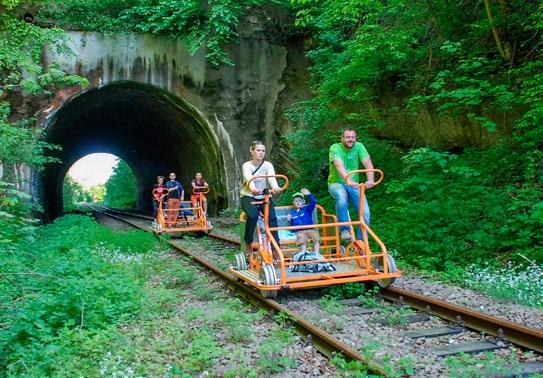
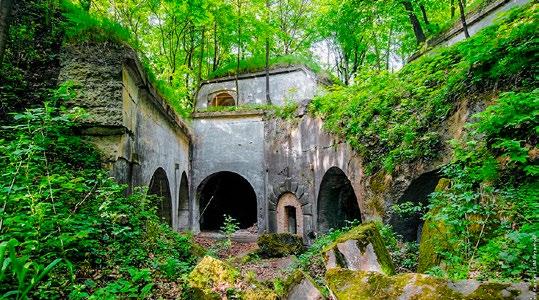
The second place that demands your attention is the Ursa Maior Brewery (Uherce Mineralne 122A, www.ursa maior.pl) surely one of the coolest spots in the region and worth dropping in for both their bar and shop. Priding themselves on their commitment to the environment and local community, this microbrewery not only offers dozens of delicious beers, but also tasty regional snacks and a range of local products and art. Contact them in advance for a tour of their brewing process, and be sure to fill your trunk with 6-pack samplers of their finest brews.
Ustrzyki Mountains Summit Hike
This hiking trail, known in Polish as the Korona Ustrzyckich Gór trail, or the 'Crown of the Ustrzyki Mountains' trail, connects the five tallest peaks surrounding Ustrzyki Dolne - the regional capital of Bieszczady. The scenery and views are spectacular, and the peaks are all relatively close together. None of them are over 1000m making this hike more about stamina than strength. Are you up to the challenge?
Route Conceived by the Bieszczady Centre for Tourism & Promotion in Ustrzyki

Dolne, this ambitious hiking trail begins at their office (Rynek 16), then connects the summits of Kamienna Laworta Mały Król Holica Gromadzyń and Orlik from which there is a trail descending back to Ustrzyki Dolne. That said, the peaks can be done individually, and in any order. The 5 Summits route actually connects many short hikes along a multitude of different trails with different colours, and it’s best to study the map and create your own route based on your own ability and timeline. In that sense, it's more of a hiking challenge than an actual trail.
Sites
Hiking the peaks around Ustrzyki Dolne is really an opportunity to immerse yourself in nature, but there is plenty of evidence that you aren’t completely in the wild. Gromadzyń features a ski station, near which you can see trenches dug during both World War I and II. Similar sites can be found in Kamienna Laworta, Mały Król and Orlik - all marked as part of the Trail of Defensive Fortifications & Monuments of the Past .’ When leaving Orlik on the blue trial, you’ll also see the so-called dragon’s teeth - triangular pilings of reinforced concrete poking out of the grass that were placed there by the Germans to stop Soviet tanks in 1944.
One of the main tourist attractions in Ustrzyki Dolne itself is the 'MŁYN' Museum of Milling & the Countryside (ul. Fabryczna 12, www. mlynbieszczady.pl), where you can not only see agricultural artefacts and learn about the history and process of grinding grain, but also participate in culinary workshops making local specialties like proziaki (sodabread rolls), buckwheat rolls and cabbage soup. If you aren’t in the mood to do the cooking yourself, the adjoining tavern ( Karczma w Młynie) is the perfect place for a beer and a hot, hearty meal of local cuisine after a good day's hike.

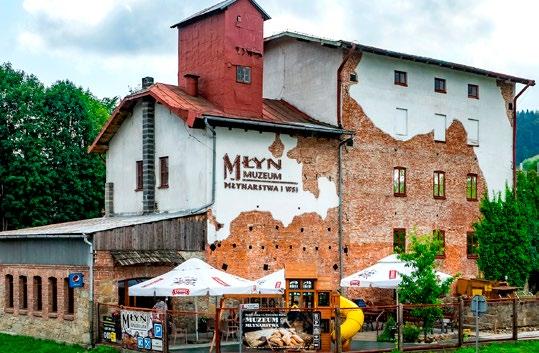
'Lookout' for these Observation Towers
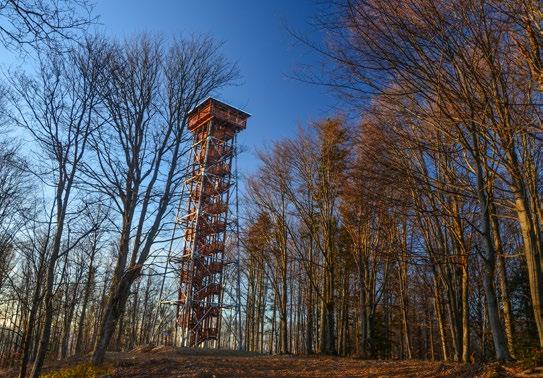
One of the perks, if not the very point itself, of reaching a summit, is the great views you get from the top...unless there aren't any. That's where these observation towers come in, lifting you above the treeline to look out over majesty of the land in all directions. If you're planning a hike, consider these towering options.
Muczne
Deep in the Bieszczady Mountains, just a stone’s throw from the border of Ukraine, the epic vistas from the Muczne Observation Tower are well worth the effort expended. The tower itself is 34 meters high and stands atop Jeleniowate peak (907 meters above sea level). On the trail there you'll get a dark reminder of the past at Brenzberg Forester's Lodge, where the Ukrainian Insurgent Army massacred 74 Poles in 1944. The hike to the tower takes only about 40mins from the start of the trail, and entry is free. There is also a terrace for observing beaver a short distance down the road from the trailhead, and a popular hiking trail to Bukowe Berdo also begins in Muczne.
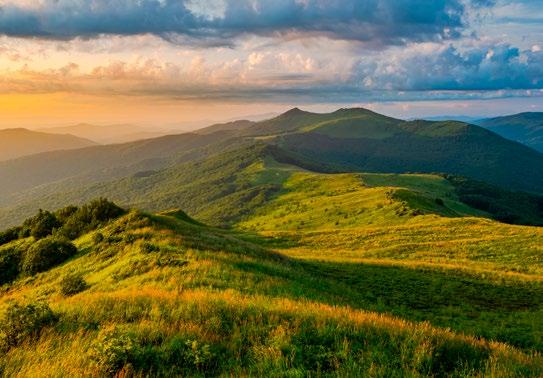
Practical Information
Start: Dynów (recommended), Słonne or Chyrzyna
Finish: Słonne, Chyrzyna or Krasiczyn (recommended)
Distance: varies from 18 -59km
Duration: 1-3 days
Choose from the following stages, or plan to camp and do all three: Dynów - Słonne: 18 km/3-5hrs
Słonne Chyrzyna: 26km/5-7hrs
Chyrzyna Krasiczyn: 15km/3-5hrs.
Recommended for: Groups, families, anyone with a moderate level of fitness of almost any age.
Equipment Rental: Water Team (www.waterteam.pl; tel. (+48) 506 514 999; water.team@wp.pl) organises kayaking all along the San River from Krzemienna to Wapowce. Prices start at 100zł but depend on the route. Included is a 2-person kayak, life vest and transport to the drop-off point.
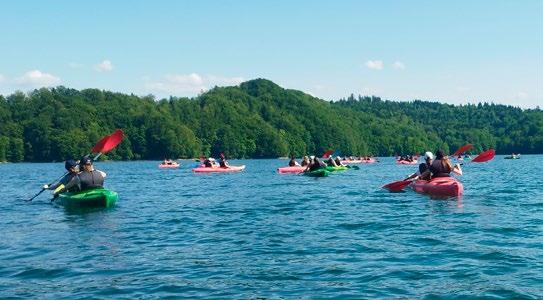
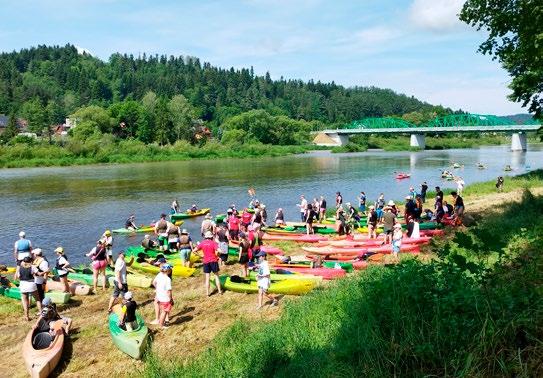
Practical Information
Start/finish: Przemyśl Market Square
Distance: 33.7km total (northern route only)
Przemyśl Market Square Kuńkowce (4.8km) - Fort Łętownia (6.6 km)
- Fort Brunner (9.1 km) - Fort Duńkowiczki (15km) - Żurawica (19.1km)
- Fort Bolestraszyce (23.8km) - Arboretum (24.5km) - Przemyśl Market Square (33.7km)
Duration: 5-6hrs with extended stops for exploration, sightseeing and relaxation.
Recommended for: Anyone with a moderate level of fitness and some cycling experience.
Equipment Rental: You can rent bikes from Azymut Bike Roots (ul. 3-go
Maja 30; tel. (+48) 16 677 70 88) in Przemyśl; prices range from 59zł/day for a standard bike to 250zł/day for a fully electric model.
Practical Information
Start/finish: Uherce Mineralne train station (Uherce Mineralne 62A)
Distance: 5.5-12km
Duration: 50-90mins
Recommended for: Young and old, particularly families and large groups, history and railway buffs, even kids and adults who cant ride a bike. Stable and sturdy, there's simply no way of tipping the trolleys over. Each trolley has two front seats with pedals (and foot brakes) and a bench in the back (without pedals) which can seat two adults, two adults and one child, or three children.
Equipment Rental: Organised by Bieszczadzkie Drezyny Rowerowe (www.drezynyrowerowe.pl ), see their website for the weekly schedule of routes and times. Prices range from 110-140zł per trolley depending on the chosen route.
Cergowa
Cergowa's iconic silhouette is a symbol of the region. Rising just southeast of the town of Dukla, this forested hill actually has three peaks, the highest of which is 716m and beset with an iron cross and observation tower. The tower itself is almost 22m high, resembling a drilling tower characteristic of the area's oil boom in the late 1800s. It provides a superb panoramic view of the Low Beskids, Carpathian Foothills, Slovakian Carpathians, and even the Tatra Mountains. To get there, take the red trail from Nowa Wieś, or the yellow trail from Dukla. If you choose the latter you'll pass the 'Golden Well' ( Złota Studzienka), where a Chapel of St. John of Dukla is located. It is said that St. John began his life as a hermit at this spot, and some believe the natural spring inside the shrine has healing powers.
On the northern side of Cergowa is the 'Millenium Reserve' (Rezerwat Tysiąclecia) - a 63.5ha nature reserve of beech and fir trees. Keep your eyes peeled for slit caves and fire salamanders as you hike through the woods, and be aware that the steep trails become very slippery after a rain.
Practical Information
Start/finish: Ustrzyki Dolne
Duration: Varies depending on chosen route, fitness level and ambition. All five peaks could potentially be summited in one long day, but it's better to complete the challenge over several days using Ustrzyki Dolne as your base. Take each summit at your own pace and enjoy your surroundings.
Recommended for: Avid hikers and outdoor enthusiasts in good health with a fair amount of experience; children over 8 years old who are prepared to walk long distances.
Further Info: Aside from sunscreen, snacks, layered clothing, plenty of water and other basic hiking essentials, the best thing to take is a good map of the area, with all the trails marked. Get one at the Bieszczady Centre of Tourism & Promotion (Rynek 16, Ustrzyki Dolne; tel. (+48) 13 471 11 30), where the helpful, friendly staff will also be able to answer any questions you have.
Czarnorzeki
As far as observation towers go, this is a bit of an odd one. For one thing, it’s modern built in 2020 - but in a rustic highlander style, and more resembles a fortification tower than a typical observation point. Comprising three levels, the bottom two are made of brick, with the interiors used for exhibition space and various events. The building is topped with a covered terrace made of wood, with a wooden access stairway winding around the lower floors.
Located just north of Krosno in Korczyna, the building stands atop Działy Hill at a height of 490 metres above sea level, and offers one of the widest panoramas of the Polish Carpathians. Entry is free and you don’t even have to go on a hike to get there, park right outside.
If you are up for a walk in the woods, Czarnorzeki is full of beautiful forest walks with some interesting rock formations and small waterfalls nearby. Krosno - the largest town in southern Podkarpackie is only a 15min drive away, and boasts several cultural attractions, namely the Glass Heritage Centre and the Podkarpackie Museum, in addition to a charming market square.
